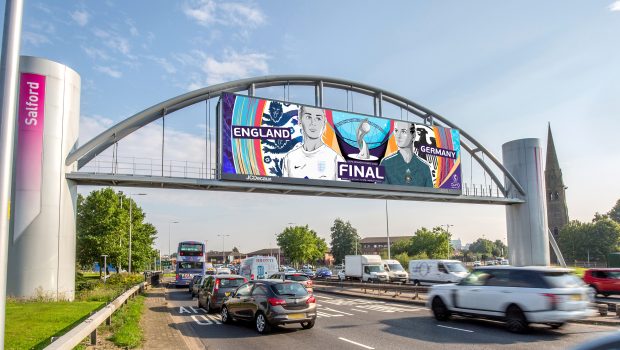Leveraging pDOOH in Privacy-First Marketing: Interview with Dom Kozak, JCDecaux
by Mathew Broughton on 1st Aug 2022 in News

As programmatic digital out-of-home (pDOOH) continues its strong recovery following the coronavirus pandemic, ExchangeWire speaks to Dom Kozak, head of programmatic at JCDecaux, to determine how the channel should be considered within the marketing mix, alongside the benefits it offers to advertisers.
What are the targeting and measurement capabilities in pDOOH, and how do these differ from non-programmatic DOOH and traditional OOH?
Out-of-home is all about context which boils down to location, environment, and what a consumer is doing at that point in the day. For a non-programmatic OOH, or DOOH, campaign, the targeting boils down to that context. Regardless of how you buy OOH, brands can measure changes in both online and offline metrics during the times that OOH campaigns are running.
With programmatic, you build on that location and context targeting, and therefore measurement too. If your target audience is only in a certain location at certain times in the day, for example, programmatic dayparting enables you to optimise your investment and reduce wasted spend.

Dom Kozak, JCDecaux
If you extrapolate that further, you can run different strategies across different locations based on your target audiences’ behaviour and culture in each of those locations; and make sure that the advertising you're showing reflects the community that’s seeing it in an authentic way. Building on that again, with programmatic, you can start to consider if your audiences’ mindset changes based on external factors, such as weather. Are there other influences that your brand might be synonymous with, such as sporting events for Gillette for example, or key calendar dates? Are there other factors which may be relevant to targeting your campaigns? Stock levels or sales events for example? Again, you can target around those and measure around those as well. That's a real difference in programmatic DOOH, that ability to be both proactive and reactive.
What it boils down to is that, with programmatic, you still have context and location, but you can arm yourself with a multitude of additional data and use that to turn campaigns on or off at the push a button; swap a creative in and out automatically to upweight or downweight based on all those factors; and run campaigns in a more synergistic way with other channels directly in your DSP of choice.
To summarise where pDOOH has something over a traditional methodology:
- Precision, but still at the scale of a broadcast medium.
- Data, first- second- or third-party can be used to optimise automated buying decisions.
- Control, the buyer has control while the campaign is in flight, at all times.
What are the main benefits of pDOOH for marketers, particularly in the context of identifier deprecation in desktop and mobile environments, and the shift in emphasis towards attention?
The deprecation of the third-party cookie on Chrome is obviously a challenge for marketers. How do you still effectively track, target, and retarget consumers online, and then also attribute that tracking and performance? We're seeing lots of different techniques out there that brands are developing a strategy towards or accelerating their existing strategies with: First-party data; independent ID solutions; the use of clean rooms to marry data up, etc.
For pDOOH and DOOH in general, research by Lumen shows that if you prime audiences with advertising on a public screen, you improve awareness and attention in other channels. Furthermore, the same research shows that OOH helps to make up any loss in click-through rate in cookieless environments. What that means then for pDOOH is that we're playing two roles in this space: all of the benefits of traditional broadcast media, but also amplifying the effectiveness of those online channels in light of the deprecation of the third-party cookie.
On the attention point specifically, OOH by its very nature is virtually unmissable. Whether it’s large format screens or lots of smaller screens in a single location, it’s part of the fabric of the environment we live in. Once you layer on that programmatic buying capability, you can start to buy the most high-value attention that delivers the best results for your business.
How will advanced capabilities with dynamic creative optimisation (DCO) help further the value of pDOOH for marketers?
As with other digital channels, in pDOOH, DCO is all about harnessing the power of flexibility at scale, swapping out creatives and continually increasing relevancy. There are lots of different ways to do this, whether it’s using context e.g. weather, to show different products when it’s raining or sunny, or cultural triggers like Mother’s Day or Climate Week, or news triggers. When UK prime minister Boris Johnson resigned, for example, we saw some great creative posts out there. Then there’s the ability to use your own product feed and sales data to trigger DCO, e.g. stock levels in local stores, or promotions, or your own customer data.
DCO also enables brands to test and optimise messaging, which is very tricky to do in a traditional OOH world. Finally, from an omnichannel perspective, you can start to think about sequential messaging, once you're combining channels together, to make sure that you've got a unified and holistic brand experience for the consumer.
How should pDOOH be considered by agency and marketer professionals in their marketing mix from both a branding and (now) a performance perspective? Where could pDOOH sit in omni-channel campaigns?
I've worked in OOH for the best part of a decade, and I think it's how it's evolving is really exciting. Brand-building channels are starting to transform into full-funnel mediums. In TV we’ve got smart TVs with integrated streaming apps, streaming devices, and internet-enabled set top boxes and these are all capturing consumer insights, using that data for targeting and to build better advertising solutions for brands. The same evolution is happening in pDOOH.
This additional audience data that’s available through programmatic can be layered onto the campaign as part of the planning process, and as part of the activation process as well. We're seeing some interesting and rich datasets being applied across multiple use cases but there are two that really stand out. We've got a relationship with dunnhumby, so we can access that rich second-party data source for brands running campaigns at Tesco store locations. Similarly with airport audience data, working with partners such as Heathrow, we can help brands better target their desired audiences. When you add on contextual signals, such as weather, sentiments in social, etc, you become much more holistic in your campaign planning.
As we're transforming these traditional brand-building channels, which historically might have been booked several months in advance, meaning perhaps the data wasn't that relevant at the time the campaign actually went live, we can now activate these in a real-time fashion. This in turn means that traditionally broadcast channels are being used more throughout the marketing funnel, not just at the top. For marketers, traditional lower-funnel campaign planning needs to involve these new channels, and they should also think about the buying mechanics. They need to be interoperable with the existing channels from an omnichannel perspective, meaning they should be available and transactable in a DSP or in a single platform in the ways that other channels are.
How do buying strategies for pDOOH compare to non-programmatic DOOH and traditional OOH? How has adoption of pDOOH helped marketers to adapt to changes in leisure versus business footfall following the coronavirus pandemic?
It depends on your objectives and about how the strategies change. There's nothing wrong with traditional OOH strategies, but now we are thinking about adding different channels into lower-funnel strategies, it has to start with your objective. We'll see, for example, pDOOH being used as part of a long-term hold, which might have multiple brands in it from the same advertiser. As I mentioned before, you could use things like sales data and seasonal conditions to upweight and down weight that campaign in line with other channels as appropriate. We also see pDOOH being used for incremental reach, particularly those hard to reach audiences. We over-index for 15-35s as a channel, a famously hard audience to reach. With things like TV inflation, the end of that reach curve can be hard to access.
The thing that we're seeing the most is this ability to complement other channels and work holistically in the marketing mix. From something as simple as making sure that you are following a user journey throughout the day, for instance reaching them on CTV in the morning while they're eating their toast, then reaching them through OOH channels programmatically if they're going into work or going out for leisure; all the way through to granular data strategies to make sure that you are serving a relevant message to that condition for that individual that resonates with messaging served on another channel under another condition.
In terms of adoption based on leisure and business, obviously the audience world is still evolving. I mentioned earlier, the effectiveness of planning with data and how quickly that data gets out of date. Now, if you've got a longer planning and buying cycle, obviously that data's going to go out of date faster. As we are doing this in real-time or near real-time, you are getting the freshest and most relevant data. You are taking account of the fact that leisure and business footfall data may well change, and you're able to react to that in real time.
We've seen some fantastic work on that front for Bloemenbureau, the Holland flower council. During the heart of the pandemic, they ran a campaign via Sage+Archer in the UK, Netherlands, and Germany. This was when audiences were going in and going out, there were local lockdowns, etc. What they did was they used more real-time data to know where those audiences were, making sure that budget was being pushed to those areas where people actually were. Quite simple, but effective in making the most of the data you have and the flexibility that the technology affords.
What industry-wide developments (if any) need to be made in terms of technology or regulation to further enhance the capabilities of pDOOH?
In the UK, there are four main publishers, so regulation is relatively easy. We are fraud-free. We are 100% viewable, 100% play-to-completion. That being said, there is still a lot of education and training to be done out there. We are combining two worlds, and people who have been on the CTV journey will recognise this. We've got OOH teams who don't really know too much about programmatic technology and how that could best be applied, and digital programmatic teams who aren't that familiar with OOH as a channel and the benefits that it can bring to a marketing mix. Bringing those together is critical and is generally what my team does more than anything else.
From a tech perspective, we're seeing omnichannel DSPs starting to integrate that data in a rich way, and therefore maximise the benefit to the buyer and to the brand. From the sell-side, from us as publishers, it's about how we collaborate and how we make the most of our inventory and our relationships. In this space, probably more than ever, we are working together for the benefit of brands and of consumers.
At JCDecaux UK, we're moving into our fifth year of trading programmatically, we work with many agencies and brands that have done pDOOH for a similar amount of time. They're experts. They're ever advancing their techniques. They're working with tech partners to develop the channel further. And then we also have a set of agencies and even some of the groups who are just dipping their toe in for the first time. My call to action for those on the buy side is to talk to each other, share their work, and help everyone to learn, for the benefit of the consumers that we all serve.
CampaignDigital MarketingTargeting








Follow ExchangeWire